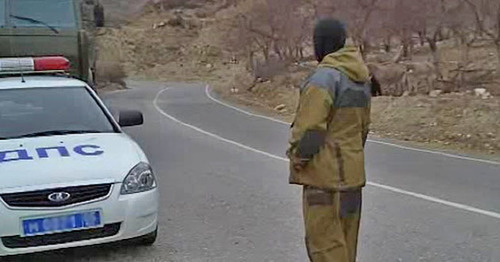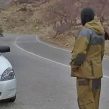
Insurgent Attacks in Dagestan Increase Despite Government Counter-Insurgency Operations
Publication: Eurasia Daily Monitor Volume: 12 Issue: 47
By:

Judging by the actions of the militants in Dagestan in February and the beginning of March 2015, a major regrouping in the ranks of the Dagestani jamaat has been completed. After the rebels in Dagestan resolved the issues of command and subordination, they have resumed attacking government forces as in the past. Earlier reports suggested that the Dagestani militants split into two camps. One camp remains in the Caucasus Emirate while another camp renounced the Caucasus Emirate’s amir and joined the new jihadist movement, the Islamic State, by taking an oath of allegiance to Abu Bakr al-Baghdadi (see EDM, January 30).
Following Said Arakansky (Kamil Saidov), another well-known leader of the Dagestani jamaat, head of the Central Sector in the Caucasus Emirate, Umar Balakhalansky, has pledged allegiance to the amir of the Caucasus Emirate (YouTube, March 4). In his statement, amir Umar warned that his sector was united in support for Arakansky, the amir of Velayat Dagestan. Amir Umar said that he would not allow anyone from the IS to encroach on the territory he controls or to poach the people under his command. This stark warning issued by amir Umar rules out the possibility of friendly relations or coexistence in partnership of the supporters of the Caucasus Emirate and of those who support the Islamic State. The two rebel groups could end up sparring with one another over who is poaching the other group’s followers.
The month of February ended with a large special operation against the insurgency in Dagestan. On February 25, government forces discovered a militant hideout in the republic’s Kizilyurt district. The police introduced a counter-terrorism operation regime in four villages in the district—Nechaevka, Sultan-Yangiyurt, Chontaul and Kirovaul. According to the republican police headquarters, seven rebels were killed in the special operation. One serviceman was killed and one wounded in the clash (Kavkazsky Uzel, March 3). That police operation would have been successful had four other rebels not managed to escape. Government forces extended the special operation for several days, but lifted it on March 2 with no results (Riadagestan.ru, March 2).
The destroyed rebel base is believed to be one of the largest or the largest one in the republic, with more than ten militants concentrated in one place. Normally, the rebels avoid gathering in such large numbers. The security services may have found out about the gathering with the help of a mole in the ranks of the insurgency and planned to intercept top-ranking insurgent commanders. The majority of the slain rebels fought the government forces, shielding the retreat of their four comrades. This was likely not simply a desertion by the rebels, but the organized retreat of a top insurgent leader. Russian media paid much attention to the fact that an ethnic Russian, 36-year-old Oleg Shalyapin, was found among the rebels killed in Kizilyurt district. That is not surprising given that the participation of ethnic Russians in the jihadist movement in the North Caucasus and beyond has become quite common.
The first week of March also was packed with violent incidents in Dagestan. On the morning of March 2, a police patrol was attacked near the village Khamamatyurt in Babayurt district. The assailant fired shots at the police car, but according to the regional command of the Ministry of Interior, no one was hurt in the shooting. The police officers killed the attacker on the spot and found a handgun on him. A Russian-made car that supposedly belonged to the slain rebel was found near the scene of the attack. It was unclear why the rebel felt obliged to shoot at the police at 5 a.m. Why did he shoot at them from a long distance if he simply could approach them and fire at close range? It was also unclear why the rebel left his car and then decided to shoot at the police. If the police account of events is true, it means that the man was suicidal and decided to end his life, dying in police crossfire. He certainly did not behave like a militant who normally knows where to shoot and from what distance. The slain man turned out to be 42-year-old Eldar Khaidarbekov from Khasavyurt district, who was not on the official wanted list (Kavkazsky Uzel, March 4).
The way militants actually attack police checkpoints was on display in an assault this week in Gunib. According to the official Dagestani news agency, on March 10, “several police officers were subjected to massive fire from the forest. The search for the perpetrators of the attack was suspended at night” (Riadagestan.ru, March 11). So the tactic of the militants is to shoot at government forces from a sheltered area and leave without losses, not to approach a police checkpoint and be killed.
Meanwhile, residents of the Separatorny district of Dagestan’s capital, Makhachkala, reported that government forces carried out a security sweep on March 9 and March 10. Security personnel in military vehicles went around to apartments and houses, conducting searches and asking bearded individuals if they belonged to the Salafist movement (Kavkazsky Uzel, March 10).
The spike in insurgent activities in Dagestan apparently prompted the government to ramp up the collection of information on all those who might be an adherent of the radical jihadst movement. As the situation clarifies itself among the rebels, the law enforcement agencies are likely to use even harsher and more illegitimate methods to suppress dissent, which will only worsen the situation in the republic.




